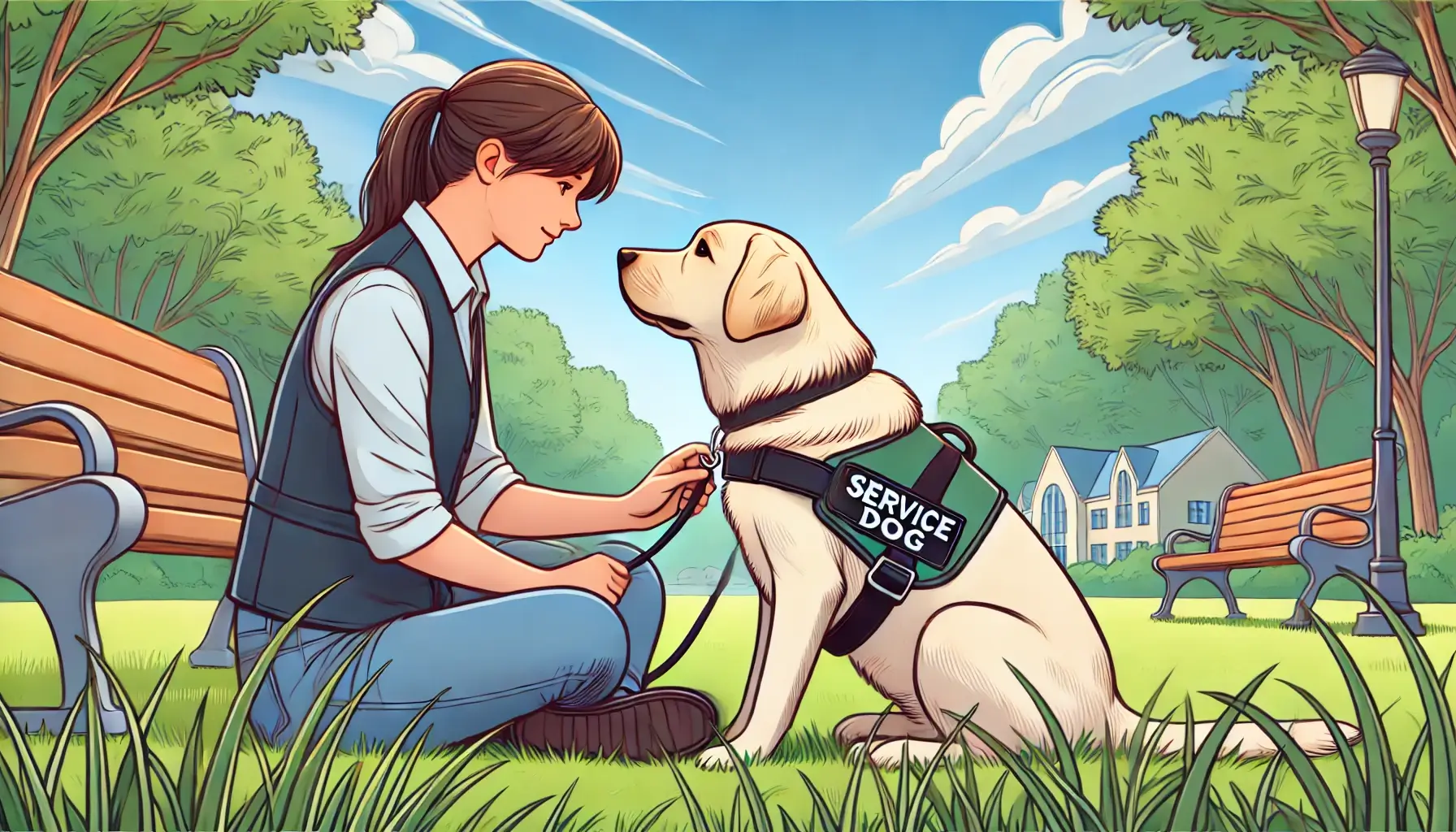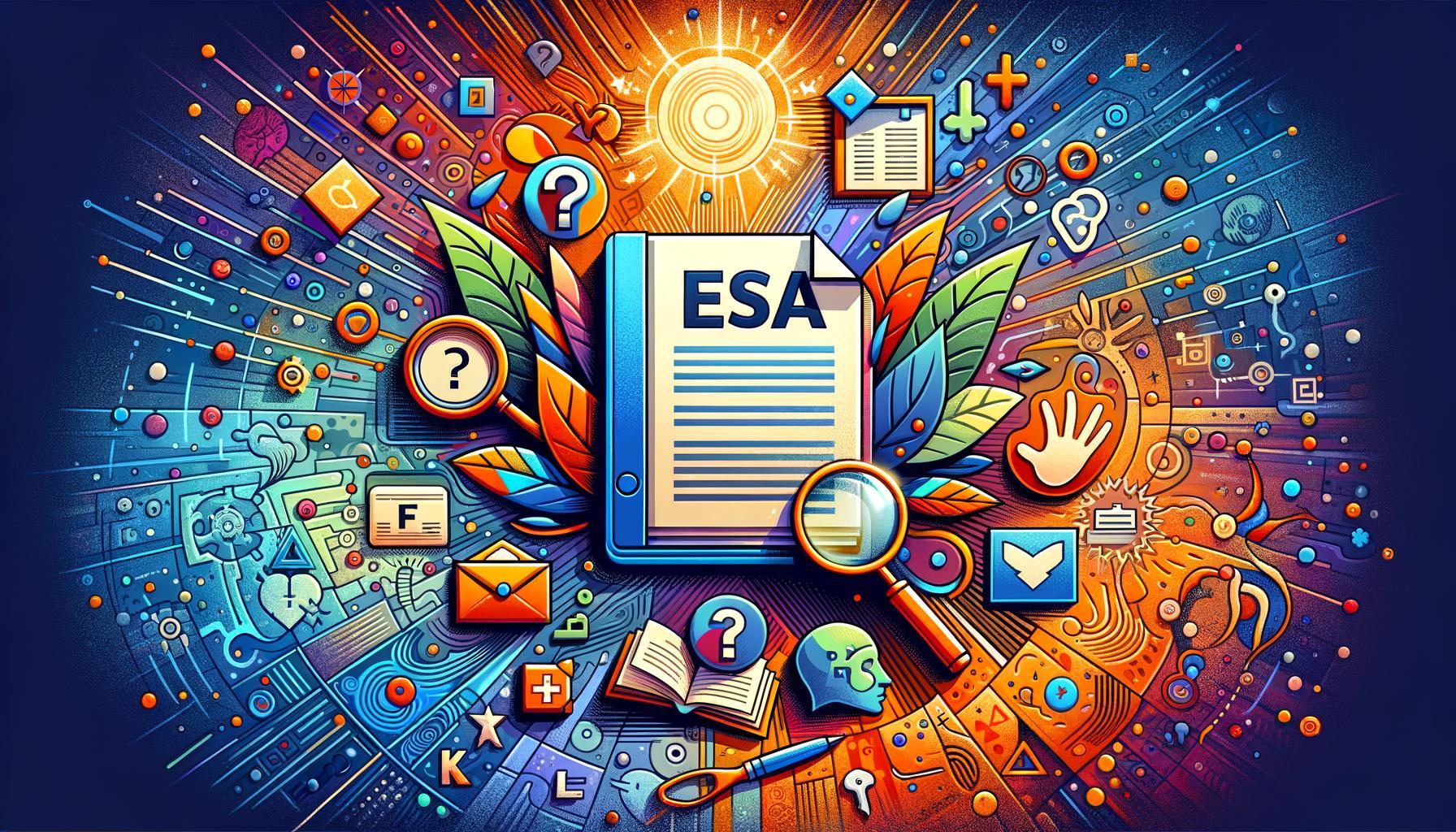Imagine this: Your patient, struggling through the highs and lows of life, finds solace in the quiet companionship of their furry friend. As a therapist, you see their bond – it’s real, palpable. Now, they need your help to ensure this companionship can continue, unhindered, wherever life takes them. Enter the Emotional Support Animal (ESA) letter - not just any piece of paper, but a bridge to a happier, more balanced life for your patient.
Crafting an ESA letter isn’t merely about following a template; it’s an art. It’s about weaving a narrative that highlights the indispensable role an ESA plays in your patient’s mental and emotional wellbeing, all while dotting the ‘I’s and crossing the ‘T’s to comply with regulations. In a world where the value of emotional support animals can be questioned, your letter stands as a testament to their necessity.
This guide isn’t just a collection of tips and tricks. It’s your ally in drafting a message that resonates with landlords, airline officials, and skeptics alike. Whether you’re navigating the nuances of mental health support for the first time, or you’re a seasoned professional seeking to refine your approach, this article has got your back. Together, let’s create a message that opens doors (quite literally!) for those in need.
Stay tuned as we embark on this journey of crafting the perfect ESA letter – a message that not only meets requirements but touches hearts.
Table of Contents
- 1. Introduction to the World of Emotional Support Animals
- 2. The Importance of a Tailor-Made ESA Letter
- 3. Key Ingredients for an Effective ESA Letter
- 4. Navigating Legalities: What Every Therapist Should Know
- 5. Crafting the Perfect Closing: A Guide to Summing It Up
- 6. ESA Letter FAQs: Clearing the Air for Therapists
- Wrapping Up
1. Introduction to the World of Emotional Support Animals
Welcome to the marvelous world where fuzzy snouts and wagging tails do more than just bring smiles; they’re our emotional anchors. Picture this: a world where your mental health has a fluffy, four-legged knight in shining armor – this is the realm of Emotional Support Animals (ESAs). ESAs are not just pets; they’re lifelines for many, providing unparalleled support through the ups and downs of life’s rollercoaster. They don’t just live with us; they live for us, making every dark day a bit brighter and every happy moment even more joyous.
Now, let’s get a bit technical but stick with me; it’s worth it. Every ESA starts their journey with a letter – not just any letter, but a magic document that holds the power to turn a pet into an official Emotional Support Animal. This isn’t Hogwarts, but it’s pretty close. The ESA letter, penned by a licensed therapist or doctor, is the golden ticket for your furry friend, allowing them to bypass no-pet policies in housing and air travel. It’s not just a letter; it’s a beacon of hope. But how do you craft this powerful piece of parchment? Ah, that’s where the magic really begins. Stay tuned, as we delve into the art of drafting an ESA letter that empowers, validates, and bridges the gap between need and support.
Why ESAs are more than just pet
- Support: They offer unparalleled emotional support.Companionship: Constant companions in the ebb and flow of life.Healing: Their presence can be therapeutic and healing.
The importance of the ESA letter
- Access: It grants your pet access to no-pet zones.Legitimacy: It officially recognizes your pet as an ESA.Empowerment: It validates the need for support and begins the journey of healing.
2. The Importance of a Tailor-Made ESA Letter
In the tapestry of mental health support, a tailor-made ESA letter acts as a crucial thread, binding the therapeutic journey of an individual to the comforting presence of their Emotional Support Animal. It’s not merely about writing a letter; it’s about sculpting a narrative that resonates with the unique struggles and triumphs of a person’s mental health journey. This artful customization ensures that the essence of the bond between the individual and their ESA is captured vividly, making a compelling case to those who might not understand the profound impact of this relationship. After all, the goal is to create not just a letter, but a bridge of understanding and acknowledgment.
- Access: It grants your pet access to no-pet zones.Legitimacy: It officially recognizes your pet as an ESA.Empowerment: It validates the need for support and begins the journey of healing.
When therapists sit down to pen an ESA letter, they don a hat that’s part artist, part advocate. The canvas awaits with sections that should be painted with thoughtful strokes. Here’s what your palette should ideally include:
- A splash of context: Introduce the individual, laying the groundwork for the narrative.
- Deep hues of the individual’s mental health journey: Detail how their mental health condition weaves through their daily life, with bold emphasis on challenges faced.
- Bright tones of the ESA’s role: Illustrate vividly how the ESA alleviates symptoms, adding quality and color to the individual’s life.
- The clinician’s signature: A seal of legitimacy, underscoring the credibility of the assessment.
| Brush Stroke | Palette Description |
|---|---|
| Context Introduction | Setting the stage with a brief overview of the individual’s background. |
| Mental Health Journey | Detailing the impacts of the condition, with emphasis on real-life effects and the need for support. |
| ESA’s Illuminating Role | Highlighting specific ways in which the ESA brings light into the individual’s world. |
| Clinician’s Seal | Reinforcing the authority and professional judgment behind the recommendation. |
Through this crafted narrative, a therapist can present a compelling and personalized story that not only meets the necessary criteria but also stands as a beacon of the individual’s needs and how their ESA fulfills them. This isn’t just about following a template; it’s about tailoring a garment that fits the wearer perfectly, ensuring their journey together is understood and respected.
3. Key Ingredients for an Effective ESA Letter
When crafting an ESA letter, think of it as mixing the perfect emotional cocktail. It’s about blending the right elements to support the unique needs of your client. Let’s dive into the essentials that make your letter not just good, but great.
- Legitimacy is key: Start with the basics—your professional letterhead. This is your cap and gown, showing you’re the real deal. Include your license number, type, and issue date. Show you’re not just anyone—you’re someone with the credentials to make this call.
- Clear Identification: Make it crystal clear who the letter is about. Full name of the client? Check. Their beloved pet’s name and species? Double check. This isn’t a mystery novel—keep the who’s who straight forward.
- Boldly State the Need: Unleash your inner detective and pinpoint why your client needs their ESA. Anxiety, depression, or perhaps something else? Lay it out plain and simple. This is the “why” behind your “what”.
And, because we love going the extra mile, here’s a table to make it even clearer:
| Element | Details |
|---|---|
| Professional Details | License type, number, date |
| Client and Pet ID | Names, species |
| Reason for ESA | Specific mental health condition |
Remember, crafting an ESA letter is both an art and a science. It’s about providing that irreplaceable support bridge between a client and their furry (or scaly, or feathery) friend. Let these key ingredients guide you to create a letter that not only meets legal standards but also warmly holds your client’s needs at its heart.
4. Navigating Legalities: What Every Therapist Should Know
Ah, legalities—the maze we all dread but must navigate. When it comes to Emotional Support Animals (ESAs), therapists walk a tightrope. Sure, it’s about crafting heartwarming letters that vouch for the invaluable companionship between human and pet. But, let’s not forget, it’s also about dotting the I’s and crossing the T’s, legally speaking. Striking the right balance ensures that the letter holds water in the eyes of landlords, airlines, and skeptical onlookers. Therapists, take note: an ESA letter isn’t just any ol’ note. It’s a document, stamped with your professional credibility, navigating the fine line between personal advocacy and legal requirements.
Before you put pen to paper, or rather, fingers to keyboard, let’s break down the key elements your letter should include to make it as ironclad as possible.
- The Professional Stuff: Your name, license type, and license number should be front and center. It’s like saying, “Hey, I know what I’m talking about.”
- The Furry Friend’s Details: Don’t skimp on details about the ESA — name, species, and why their human wouldn’t just “be okay” without them.
- The Law: Pepper in references to the Fair Housing Act or the Air Carrier Access Act, as they apply. It shows you’re not just compassionate; you’re informed.
Here’s a neat little table to ensure your ESA letters are not just touching but also legally sound:
| Element | Description | Why It Matters |
|---|---|---|
| Professional Credentials | Your Name, License Type, and Number | Gives the letter credibility |
| ESA Details | Name, Species, Reason for Need | Personalizes and legitimizes the need |
| Legal References | Fair Housing Act, Air Carrier Access Act | Shows knowledge of applicable laws |
In the end, it’s about more than just a letter; it’s a declaration of support, a passport for companionship that crosses both hearts and legal hurdles. Keep it heartfelt, keep it informed, and you’re golden.
5. Crafting the Perfect Closing: A Guide to Summing It Up
Wrapping up your ESA (Emotional Support Animal) letter is like tying the perfect bow on a present. It’s your last chance to leave a mark, making it crucial to be warm, yet professional. Don’t just say goodbye; instead, invite further conversation. Emphasize your availability for any queries and your willingness to provide additional support or documentation as needed. This not only shows empathy but also extends a bridge for ongoing communication.
Below, find a snazzy bullet-point guide to ensure your closing has just the right mix of flair and formality:
- Make it personalized: Mention the client’s and animal’s name again, reinforcing that personal touch.
- Express support: Reiterate your belief in the benefits of the ESA for your client.
- Invite questions: Clearly state you’re open for further clarification, making it easy for the reader to reach out.
- Provide contact details: Don’t forget to include your email and phone number.
- Sign off warmly: Use phrases like ”Warm regards” or ”With support,” followed by your name and title.
Finally, remember that your closing isn’t just the end of a letter; it’s the opening for further dialogue and support. Craft it with care, and you’ll not only help your client but also pave the way for a smoother ESA certification process.
6. ESA Letter FAQs: Clearing the Air for Therapists
Navigating the ESA (Emotional Support Animal) landscape can feel like deciphering ancient hieroglyphs. But don’t fret! We’re here to arm you with the knowledge to clear the haze surrounding ESA letters. First things first, let’s bust a common myth: No, ESA letters are not a one-size-fits-all ticket for pets to enter restaurants or snag an airline seat. They’re a serious tool for individuals coping with emotional hurdles, proving that their furry companion is more than just a pet—it’s necessary for their emotional well-being.
Let’s dive into the nitty-gritty with some FAQs that pop up like mushrooms after rain:
- Can therapists from any state write an ESA letter? Yup, as long as they’re licensed in the state where the client resides.
- Is there an ‘expiry date’ for ESA letters? They generally need a refresh every year, just to keep things up-to-date.
- Do therapists need to use a special template? No strict templates here, but the letter should cover specific details like the therapist’s license number and an acknowledgment of the patient’s need for their ESA.
| Question | Quick Answer |
|---|---|
| Does the ESA letter guarantee housing rights? | Mostly, yes. It can help bypass pet restrictions in housing. |
| Can any pet be an ESA? | Technically, yes. But they need to bring comfort and support. |
| Is there an official registry for ESAs? | Nope, and be wary of any ‘official’ registries online. |
Embrace this treasure trove of clarification as your shield against the swirling winds of confusion. With this knowledge, you’re equipped to craft an ESA letter that’s not just a formal necessity but a beacon of support for those in need.
Wrapping Up
And there you have it, folks! Navigating the ESA letter territory doesn’t have to be like finding your way through a dense, uncharted jungle. With the right compass – our template and tips – you’re more than equipped to craft messages that hit home, resonate with landlords and airlines, and, most importantly, support your clients in their journey alongside their furry (or feathery, or scaly) companions.
Remember, every word you jot down carries the weight of your client’s well-being and their companion’s future. It’s not just about getting the green light for a living situation or travel; it’s about acknowledging the profound bond between your client and their emotional support animal. It’s about fostering an environment where that bond can thrive, in homes and in the skies.
So, put that pen to paper, or fingers to keyboard, with confidence. Use empathy as your north star, and let our guide be your map. Together, we can ensure that every letter is a beacon of hope for those navigating the challenges of mental health with their loyal companions by their side.
As we close this chapter, remember: the journey of a thousand miles begins with a single letter. Make it count.







Leave a Reply